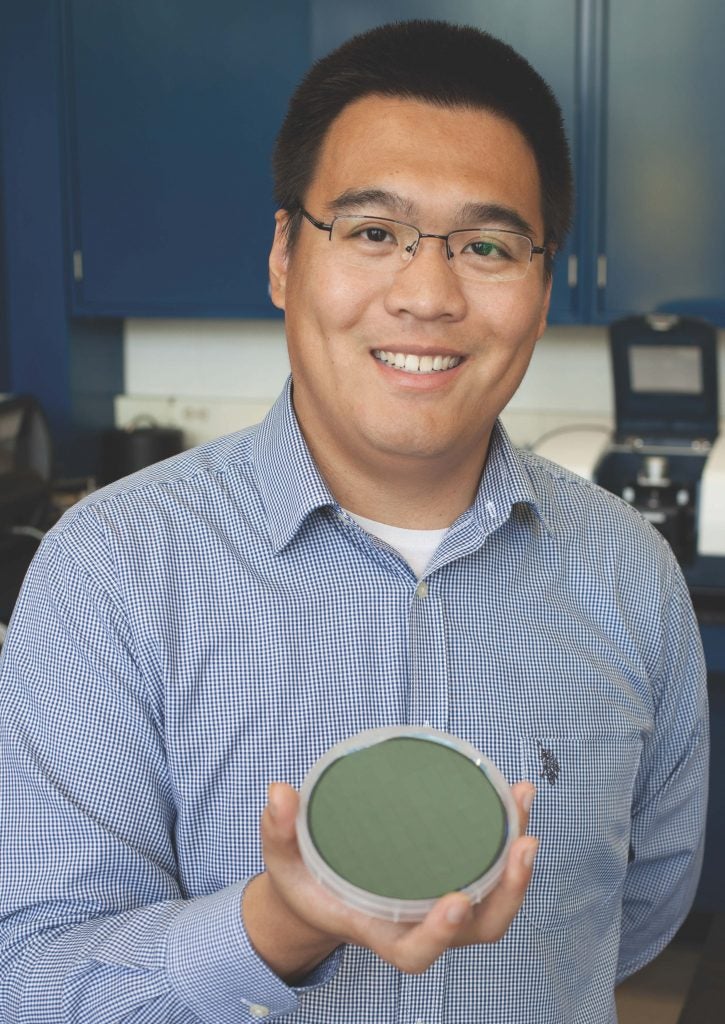Written by Todd McLeish
Yi Zheng, University of Rhode Island (URI) assistant professor of mechanical, industrial, and systems engineering, may soon improve the detection of lung cancer, make solar cells more efficient, and monitor harmful algal blooms in the ocean.
All chemicals and bio-molecules emit and absorb electromagnetic radiation over a wide spectrum of different wavelengths, depending on the material and its temperature. Zheng is creating biosensors to detect the specific wavelengths emitted or absorbed by particular objects.
Zheng, who earned master’s and doctoral degrees from Columbia University and joined the URI faculty in 2014, has already completed the design for a 3D-printed, hand-held device the size of an iPhone to detect three species of marine algae that produce toxins harmful to humans. With funding from the National Science Foundation (NSF) Experimental Program to Stimulate Competitive Research (RI NSF EPSCoR) and matching funds from the Rhode Island Science and Technology Advisory Council (STAC) in 2016, he and colleagues from URI and Roger Williams University set up an “opto-electronic system” that uses an LED light source and a photodetector integrated with a nanostructured wavelength-selective thermal transmitter to target the unique wavelengths of the three algae species. This system can monitor waterborne contaminants such as toxic algae and others in coastal waters.
“You just insert a seawater sample and the LED light source generates the particular wavelength for each species,” Zheng explains. “If the sensor doesn’t detect the wavelength, that means it’s been absorbed by the algae. A measurement of zero, for instance, means that there is a large quantity of that species in the sample.”
Zheng is taking a similar approach to improving the energy conversion efficiency of solar cells.
Conventional solar cells convert sunlight to energy at an efficiency rate of just 25 to 30 percent, in part because the cells are only sensitive to the particular wavelengths emitted by visible and near-infrared light. Zheng’s research suggests that the energy conversion efficiency could reach 84 percent with an improved technology that is sensitive to other wavelengths, such as those from ultraviolet or infrared light.
With this in mind, he has designed a thin film containing a three-dimensional nanostructure that could be applied to the top of solar cells. The black film absorbs more energy over a wider spectrum of light from the sun, and the underlying nanostructure, made of silicon carbide and tungsten nanoparticles, modifies the emission spectrum to match the absorption characteristics of the solar cell.
Zheng applied for a grant from the NSF to continue work on the project, and is contacting solar companies in the region to conduct additional tests of his thin film.
Zheng’s latest funded project involves the design of a nanoscale biosensor for the early detection of lung cancer, which he believes will be crucial to lung cancer therapy and increase a patient’s chance for a full recovery. He recently received three grants, from the Rhode Island Foundation Medical Research Fund, the Rhode Island IDeA Network for Excellence in Biomedical Research (RI-INBRE) Pilot Research Development Award, and the RI-INBRE Early Career Development Award.
“Detecting lung cancer is far from a mechanical engineering project, but I think I can apply my knowledge of small-scale heat transfer to design a thermal infrared biosensor to take advantage of the microscale and nanoscale thermal effects in cancer biomarkers,” he says.
Zheng and his research team are building a highly sensitive and selective biosensor that can be tuned to the desired wavelengths of early lung cancer biomarkers to indicate whether the patient is at high risk and should be screened further.
“The first thing we need to do is exactly locate the particular wavelengths we want,” Zheng says. “No one has done this before. Then we have to narrow the emission spectrum down further to design a wavelength-selective biosensor that filters out the wavelengths we don’t want. The narrower the spectrum, the more accurate and effective it will be.”
While these three projects show the most promise, Zheng takes pride in a recent accomplishment for which he has not yet identified an appropriate application. He created what may be one of the smallest nanofibers ever made, constructing a thread of polystyrene embedded with silver nanoparticles that is just 100 nanometers in diameter or about 400 times thinner than a human hair.
“My goal is to increase its thermal conductivity so it’s comparable to that of metals,” he says. “The advantages include reduced cost, light in weight, easy fabrication, tunable high thermal conductivity, and unique mechanical and electrical properties.”
While nanotechnology is currently a popular buzzword among scientists and engineers, many of whom think it can address most of the world’s challenges, Zheng says it’s important that the macroscale – humans – aren’t left out of the equation.
“I want my research to go full circle,” he says, “from the human macroscale to the microscale to the nanoscale and back to the macroscale to benefit humans.”
This article was originally published in the spring 2017 issue of Momentum: Research & Innovation, the magazine of URI’s Division of Research and Economic Development.

